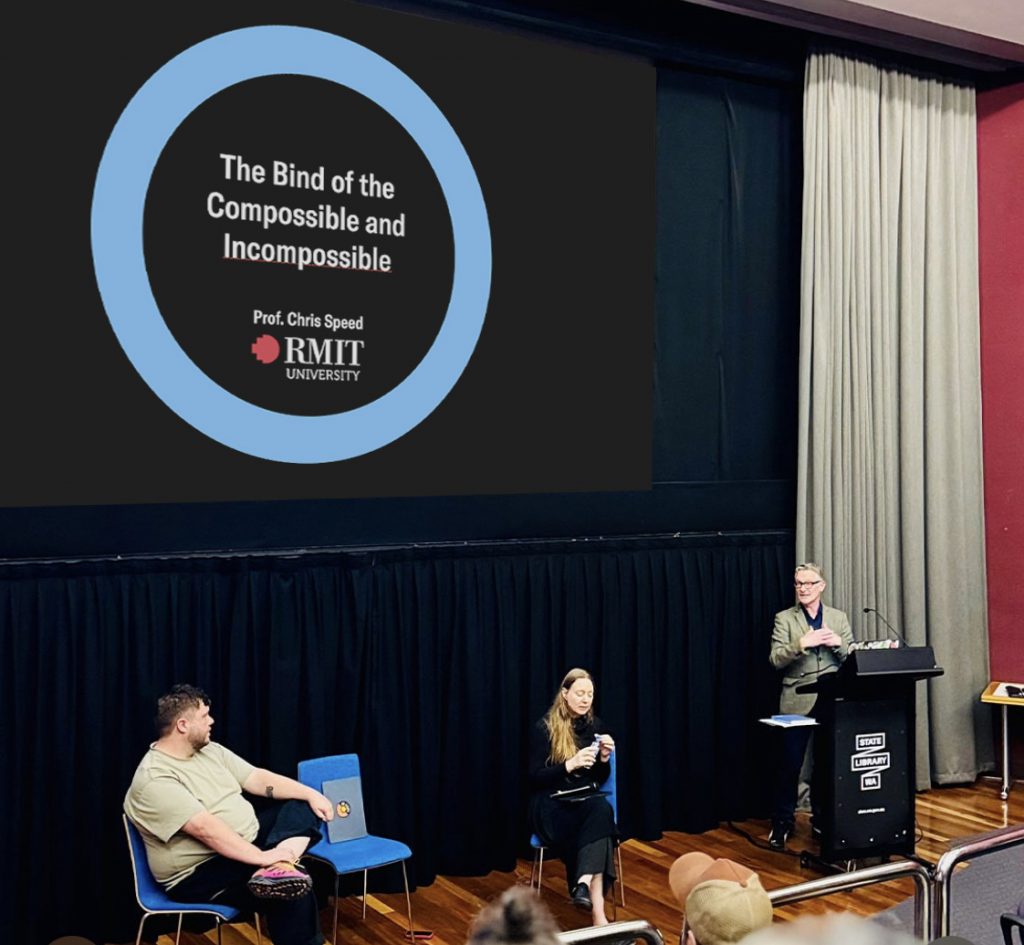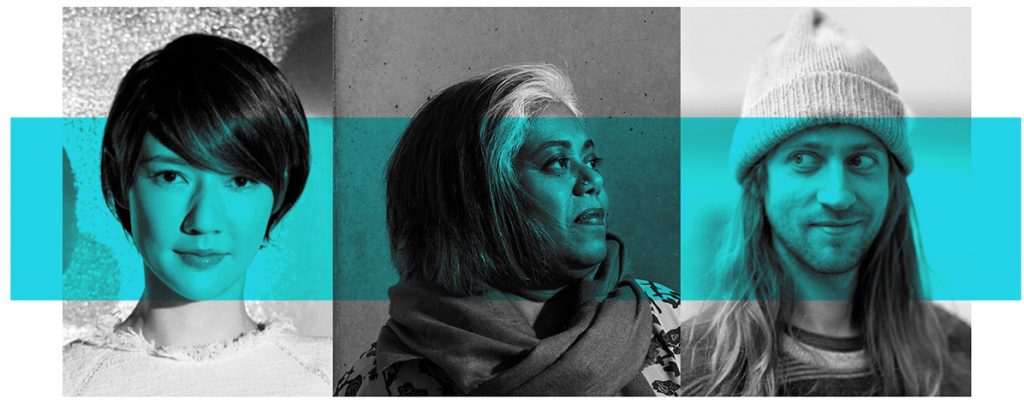Take Me I'm Yours – DIS2012 Demo
A month or so ago Duncan, Kristin and I demo’d Take Me I’m Yours at the DIS2012 conference in Newcastle.
This demo introduced a smart phone application that was developed during the Heritage Inquiries: A Designerly Approach To Human Values workshop at DIS 2010, organised by Giaccardi and Sejer Iversen. Take Me I’m Yours extends the current continuum of personal barcode scanning software for smart phones that is currently limited to two modes: reading and writing, and adds a further dimension: actions.
This movie is explains the fun of it:
Users of smart phone based barcode scanning applications are familiar with reading both one and two dimensional barcodes to link to internet based materials. Recent applications have also introduced a ‘write-back’ function that allows users to attach messages and stories to objects. The designers of Take Me I’m Yours speculate a design fiction in which object databases may begin to identify associations and propose ‘actions’ to a user.
The demonstration will offer delegates an opportunity to experience a sense of what it may feel like in the future for objects to begin telling us what to do.
INTRODUCTION
Take Me I’m Yours is a third generation Internet of Things (IoT) artwork that evokes ‘actions’.
1st Generation – Read Only
The first generation of IoT technologies simply recall immaterial data that is associated with an artefact when it is scanned. Barcode scanners in supermarket checkouts, or near-field scanners used to check passports at airports, devices ‘read’ tags and codes and recall data upon that item from a networked database.
2nd Generation – Read and Write
Second generation IoT technologies allow for the writing back of data on to a database via a tag. Systems such as www.talesofthings.com or www.stickybits.com allow consumers and owners of artefacts to ‘write’ information back to a tag allowing others to recall and further comment.
3rd Generation – Read, Write and Act
A third generation developed by the artist and designers of Take Me I’m Yours involves not only the reading and writing of/to tags, but the passage of instructions and actions through objects to facilitate their movement through space/place. The tendency for the first two generations of IoT is that objects are not shared in the actual world – only the immaterial data that they are associated with.
CONTEXT
This demonstration responds to the adoption of barcode scanning software that has become available for smart phones. Previously restricted to use at supermarket checkouts, and connected to local and closed databases, the traditional barcodes that are attached to consumer products have become useable by smart phone users. Software such as Red-Laser, Food Scanner and ShopSavvy available for Android, iPhone and Blackberry smartphones allows users to access data associated with barcodes. Companies such as Google Merchant and Amazon support connections between the two barcodes models: UPC (US and Canada) and EAN (Europe, Australia, South America, Africa), and make it possible for the public to link to common product information. Scanning a product with a barcode reader allows users to compare prices across a range of stores, check availability in second hand stores and even give location based information about where the nearest store may be in order to purchase the same product.
More recently applications such as StickyBits (http://www.stickybits.com) allow users of smart phones the facility to scan a product code, and attach their own media to it. Short text stories, a photograph or video can be posted to the StickBits database and is made available for others to read when scanned again using the same software. Turning the barcode into a media channel, mobile phone camera scanners offer companies and individuals a conduit through which marketing materials can be fed, and social data can be attached through locally optimized websites services.
Whilst StickyBits tends toward using codes that are shared across whole product lines, other platforms offer the public a chance to create new codes for unlabelled items, and tag them with memories, stories and media content. The Tales of Things system (http://www.talesofthings.com) allows individuals to pick a single item, attach social data to it through a website that then generates a unique barcode for them so that others who come across the object can retrieve that data. Aimed at encouraging the public to record personal stories onto objects, the Tales of Things website demonstrates that some objects that are moving through the world are not only containing quantitative data to ensure product integrity and ‘freshness’, but many are beginning to contain qualitative data that is intended to affect how users interpret and use physical objects.
Reflecting upon the development of the consumer experience from ‘reading’ codes, to beginning to ‘write on’ to codes, participants of the Heritage Inquiries: A Designerly Approach To Human Values workshop at DIS 2010, began to hypothesis about the next user experience: a context in which objects begin to talk back. Developed as a ‘sketch’, the Take Me I’m Yours idea speculated a scenario in which ‘things’ may begin to gain a level of agency and start to demand actions of us. The cultural and technical phenomenon in which all objects are connected across networks, and branded as the Internet of Things, is largely framed as a relationship between scanners, tags and databases. Take Me I’m Yours anticipates a context in which connections between databases may lead to emergent characteristics including assumptions to be made about the needs of a user, or even the needs of an artifact itself. A design fiction in some respects, the workshop attendees recognised that whilst the development of a digital system from which emergence may require resources beyond the reach of the team, developing a platform that simulates the experience may not be so difficult.

Figure 1. An representation of a future context in which objects will begin telling us what to do.
DEMONSTRATION
Take Me I’m Yours is an iPhone app that allows users to read a traditional barcode that is associated with everyday consumer items. Upon scanning a code the user is prompted with an action to do something with the artefact: “Give me to your neighbour”, or “Take me to work with you”.
Through actions that correspond with ‘real world’ contexts ‘Take Me I’m Yours’ encourages the movement of things through people, places and circumstances to provoke new histories and question the perceived function and value of artefacts. When the Cornflakes packet is browsed at home by a family and it says “Turn me inside out and design your own packet”, the artefact is given a voice that provokes a self-transformative action.
The artists would like to demonstrate the Take Me I’m Yours in Newcastle during DIS 2012. By associating actions and instructions with a series of consumer products, any item will be able to recall an instruction. The demonstration will include a shelf containing a range of popular consumer items that all have their own bar code. Visitors to the demonstration will be invited to use their own smart phone to scan artefacts and listen to and follow the instructions from their phone. The design team will replenish the shelves throughout the demonstration and we can expect to see objects move throughout demonstration event and possibly out into Newcastle.
The actions have been written by an established artist/performer, and are intended to project a sense of agency on behalf of an object:
Take me to the window so I can see the mountains
Sit me on the windowsill with the best view north
How do I look in your house?
Open me when the sun goes down
Hum your favourite song to me
Hold me close, I’m scared of falling
CONCLUSION
In conclusion the Take Me I’m Yours demonstration is intended to provide a playful insight into a future relationship with objects in which they begin to gain agency. The value of this working ‘design fiction’ is to frame the history of users relationships with barcodes as they have moved from closed supermarket systems to more open internet based experiences.
ACKNOWLEDGMENTS
Take Me I’m Yours is a project developed by: Rachel Clarke, Christian Dindler, Daniela Petrelli, Rachel Charlotte Smith and Chris Speed during the Heritage Inquiries: A Designerly Approach To Human Values Workshop at DIS 2010, Arhus organized by Elisa Giaccardi (Universidad Carlos III de Madrid, Spain) and Ole Sejer Iversen (Aarhus University, Denmark).
Related posts

“This communication is not for you.”
Looking to connect 2 recent events / conversations (as is my want) this time to explore a fundamenta

Design Frequencies: Sharing International Practice in Design Research
Already deep into semester two here. Last semester School of Design RMIT College of Design and Socia

The Labour of the Rejected / “Walk the Plank”
Still playing catchup with so many events. A few weeks ago during hashtag#DIS2025, Mafalda Gamboa an

Design Contradictions
Two projects during Melbourne Design Week with collaborators Michael Dunbar and Liam Fennessy to exp

Paradox of Collaborative Speed
Two events in Melbourne over the past 10 days week revealed a tension across contemporary technology

Slow Materials, Slow Money: Can Design Decelerate?
Two events that I’m trying to tie together to glean some connections. The CHI panel on Regenerativ

From Food Networks to AI Governance
Back to reporting on events in Narme/Melbourne. From Food Networks to AI Governance: Reflections on

Planetary Pedagogies
Following the launch of PlanetaryCivics two weeks ago, this is the second extension to contributions

Space Debris to House Keys
Part 2 of catching up with the weeks of activity in Melbourne through February. From Space Debris to

Measuring our demise
Oh Melbourne, three parallel events that spanned the week: RMIT College of Design and Social Context